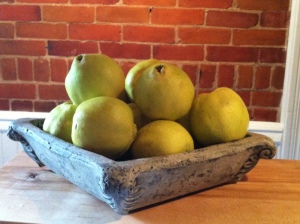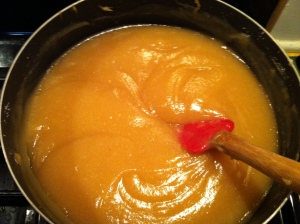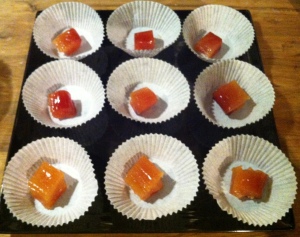
Over the weekend, my kitchen was filled with an intensely gorgeous floral, fruity aroma. This was because, on my countertop, sat a bowl of quince apples waiting to be played with.
The quince is a curious specimen of apple; it looks as if it is having a bit of an identity crisis. I think quince look a bit like a cross between an apple, a pear and a bit of lime. They can be purchased during a very small window in the fall, but they are not necessarily easy to find. They are indeed grown here in Ontario, but you may only be able to find them in higher end markets and in small quantities. Apple trees, and therefore quince trees, are members of the rose family. This, in part, explains the floral bouquet the fruit emitted in my house. Despite the sweet scent they emit when raw, they are not ideal for eating this way; they are quite hard, tart and astringent. With all this, they are not a common crop and thus are also fairly pricey.
In my childhood, quince apples were the foundation of a once-annual treat, prepared by my paternal grandmother. Although years have passed since I last consumed quince candy, I can taste it clearly with my imagination. This treat forms the basis of my post for this month; another Hungarian delicacy that brings back many memories from my Canadian childhood, and moreover uses local produce. Hungarians usually call this delicacy birsalma sajt which translates to “quince cheese”. My guess is that it’s the thick, jelly-like consistency of the candy that gives it this name. It is similar to the Spanish treat membrillo.
When I thought about this month’s preserving challenge, I was again a bit stumped. Other than dehydrating, I have not done much typical preserving. I love eating preserves, particularly savory ones, but haven’t tried my hand at it yet. I wasn’t much inspired by the idea of making jam or jelly, but I knew I wanted to make something inspired by autumn; something sweet, rich and fresh tasting. I also felt I should carry on the theme of including inspiration from my childhood and heritage. The idea of quince candy jumped to my mind and I considered carefully whether I could indeed call this a preserve. It is not dehydrated, frozen or jarred. Preserving is, by definition, a process of extending the life of a food, and quince candy does keep for about 6 months in an airtight container, or longer in the fridge. In addition, the Canadian tradition of preserving assumedly was born of the concept of sustaining ourselves during long, cold winters. This candy provides a delicious treat to warm the soul on a cold winter’s day, though I have great doubts about whether this candy will actually remain uneaten for more than a few days.
For those of you who do enjoy preserving jams and jellies, quince apples are a winner because they are naturally high in pectin. Also, the finished product boasts an esthetically gorgeous amber colour.
As a child, we ate the quince candy as a dessert treat, however it pairs nicely with strong cheese as an amuse-bouche or even as part of a main course alongside roasted meat.
Quince Candy
Ingredients
• 12 quince apples, washed, cored and roughly chopped
• 1/4 cup water
• 1/4 cup lemon juice
• Sugar (several cups, quantity varies as per below)
In a medium saucepan, combine quince, water and lemon juice. Bring to a boil, reduce heat to very low and simmer, stirring occasionally, until it takes the appearance of grainy applesauce.
Now, you should pour the purée through a sieve or food mill to get a smooth sauce. I did things a little differently because I have a Vitamix, a very powerful blender. I blended the sauce, skin and all, as I felt I could enhance the flavour of the purée while keeping it smooth.

Pour the purée back into the saucepan and for every cup of strained purée, add 1 cup sugar and mix together. Cook over low heat, stirring frequently, for 2 hours or until very thick and amber in colour. A spoon drawn through the puree should leave a firm track.
Line a cookie sheet with parchment paper and pour the hot purée into the pan. Cover with another piece of parchment paper and use your hands or a spatula on top to even out. Leave covered and let cool completely. Invert the pan onto a flat surface and remove the parchment paper.
Cut the candy into small squares or use cookie cutters to cut out shapes. It is so sweet the pieces are best cut quite small. Transfer the pieces to a clean piece of parchment paper and allow to dry for up to 3 days. Turn the pieces regularly until no longer sticky. Sprinkle with granulated sugar if desired and place in candy papers or muffin cups. Store in an airtight container in a cool, dry place for up to 6 months or refrigerate if desired. The candy tastes quite nice chilled as well.

~~~~~~~~~~~~~~~~~~~~~~~~~~
The Canadian Food Experience Project is Valerie Lugonja’s call to Canadian Foodies and Bloggers alike to unite on the 7th day of each month and creatively discover and share Canada’s unique culinary voice. You can read more about this exciting project here.


